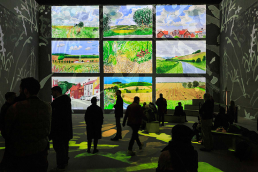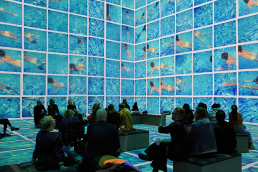This website uses cookies so that we can provide you with the best user experience possible. Cookie information is stored in your browser and performs functions such as recognising you when you return to our website and helping our team to understand which sections of the website you find most interesting and useful.
Lightroom
ProjectLightroomLocationLondon, EnglandArchitectHaworth TompkinsInstallerCreative TechnologyAcousticianGareth FrySubmitted byHOLOPLOT
The show features a specially created score written by American contemporary composer Nico Muhly and expert sound design by Olivier and Tony award-winning sound designer Gareth Fry. The aim was to create a harmonious marriage of David’s voice and Nico’s beautiful soundtrack as the two core elements, accompanied by some subtle sound effects that truly underscore the importance of audio in this unique production.
Lightroom’s sound system is supplied by Berlin-based pro audio company HOLOPLOT and was installed by industry-leading integrator and HOLOPLOT partner, Creative Technology.
The HOLOPLOT system has been the key to making the show ‘alive with sound’. In addition to solving the reverberation time of six seconds inside the space and ensuring noise pollution to the adjacent buildings is kept to a minimum, Gareth Fry also wanted to be able to create immersive sound effects that guide the visitor’s experience. HOLOPLOT’s technology combines 3D Audio-Beamforming and Wave Field Synthesis, enabling the user to precisely steer and position sound and work with reflections to create Virtual Sources to create highly tailored and unique audio experiences.
The positions of the Virtual Sources are defined inside Plan, HOLOPLOT’s sound system design software, allowing sound designers to visualize the impact of X1’s unique capabilities on any given space. The ‘bundled’ waves are reflected from the wall as if there is a point source positioned there, allowing the listener to localize the sound from a position where there is no array. It was key to the Lightroom experience that visitors would be able to localise sound from these reflections no matter where they are within the main space. To achieve this, multiple reflections were distributed along the North and South walls of the venue.
The final system design consists of two HOLOPLOT X1 arrays at either end of the room. Each array comprises four X1 Modul 96s and four X1 Modul 80-S, embedded and entirely hidden within predefined wall cavities, each at a different height. The acoustic centre of the East Array is at 4.61m and for the West Array at 6.66m. A traditional audio solution, with sources facing each other, would have created phase issues and spill between the sources.
With HOLOPLOT’s unique optimisation algorithms, the listening area can be defined along with the relative sound pressure level for each area, allowing for uniform coverage from each array no matter where the listener is positioned within the space. Each array is strategically placed behind colour-matched, acoustically transparent material, which preserves the integrity of the 360° projection surface.
HOLOPLOT’s 3D Audio-Beamforming technology also allows for the creation of multiple precise audio zones in a single space, generating multiple sound fields simultaneously – each with its own content, equalisation, level, shape, and position.
For each zone, the modules in that section form a sound field capable of enveloping the listener and operating as an independent spatial audio system. Designers can create separate scenes within a single space and ensure the synchronicity of audio content to that scene. The potential for Lightroom is endless.
The challenge for the Hockney show’s system design was the ability to work with large video resolutions and playback 10-bit video in the best detail possible for the seamless 108 million-pixel canvas. Optimised to play up to four times uncompressed 4K60 using its high-performance NVME RAID drive array and capable of playing lossless 10-bit video at 60 fps, seven of disguise’s vx 4 media servers offered Lightroom the ability to achieve high-performance video playback in a codec that presents every detail required of the fine art application.
Paired with that is disguise’s Designer software, which allowed the team to pre-visualise the content, and collaborate efficiently while achieving optimal show control and delivery. This included multi-user programming enabling the team to work simultaneously on line-up, timeline and engineering across the site. With this in place, the Lightroom team controlled all 29 projectors projecting 108 million pixels of video content.
Set to be the first in a series of unique exhibitions created in collaboration with leading artists and innovators, Lightroom’s opening show, ‘DAVID HOCKNEY: BIGGER & CLOSER (not smaller and further away)’ has been enchanting audiences. The show is a 50-minute exploration of Hockney’s work with large-scale projections that immerse visitors into the world of the artist’s imagination and is as astonishing visually as it is alive with sound.
Four and a half years in the making, Lightroom was conceived by award-winning design studio and production company, 59 Productions. The space is a joint venture between London Theatre Company and 59 Productions. It was built in collaboration with Haworth Tompkins architectural studio, as a sister space to the award-winning Bridge Theatre.
With an increasing number of immersive shows cropping up, 59 Productions wanted to do something different. Staged in Lightroom’s 14m deep basement, which enables projections up to 11m high and with narration from the artist himself, the ‘Bigger & Closer’ exhibition allows the audience to enter into Hockney’s thought process and creative motivation, generating new perspectives on some of his most well-known, as well as more recent, works.
The brief was to create an AV experience with a sound system for Lightroom that would provide good sound coverage, not bother the neighbours in the office above the main space and allow for the implementation of immersive effects. The system had to be invisible so that all four walls of highly reflective concrete could be used as unhindered projection surfaces for the high-quality imagery depicted from floor to ceiling.
Visuals are created via a large-scale projection show with 108 million pixels worth of content powered by a disguised vx 4 server.
The audio design comprises two HOLOPLOT 4×4 X1 Matrix Arrays positioned at either end of the room behind concrete-coloured cloth that disappears completely once the projection is on.
Looking for a suitable audio solution that could turn Lightroom’s ambitious concrete structure into a smooth-sounding gallery space without compromising the 360° visuals, the team realised that conventional loudspeaker solutions would need multiple wall cavities or mounting positions on all four walls to achieve the desired immersive effects.
The system had to be essentially invisible so that all four walls of highly reflective concrete could be an unhindered projection surface from floor to ceiling. The space, as built, has a reverb time of over six seconds and there is very audible background noise of projector fans, all of which is the natural enemy of intelligible sound.
Concerned about poor sound quality with very uneven coverage from conventional loudspeaker solutions and having designed multiple systems – none of them to his satisfaction – Fry suggested HOLOPLOT and a system design that only required two positions within the room, and that could deliver more creative tools to generate immersive effects. The system not only provided the answer for the current exhibit but also paved the way for future shows.
The biggest challenge for the installation was getting the speakers into position, which was mitigated with specially designed dollies to help manoeuvre the cabinets, an experienced team and good planning, everything went smoothly.
Lightroom is an immersive experience done differently. It is more personal and evokes emotions. There is a story within it, and it is sequential, so vistors can enter at any point. It is huge, but it feels intimate, and it has raised the bar in terms of technology for art exhibitions.
With the HOLOPLOT system now in place the venue is secured for future installations: any adjustments or reconfigurations of the system can be done via HOLOPLOT’s software, dispensing with the need for mechanical steering or for additional cabinets to be added.
Lightroom creates bespoke content in collaboration with artists and creatives and the ultra flexible, hidden HOLOPLOT system, seamless projection surfaces and high-quality imagery reproduction provide a limitless toolset to work with. What is essentially a concrete box becomes a blank canvas for artists to paint on.
The technology used was able to fit inside predefined spaces that required minimal adaptation to the makeup of the building. Being an immersive art gallery and experience space is the first life for this new space at Kings Cross. It will eventually be turned into a theatre, making working within the confines of the current setup such as the pre-defined audio positions all the more crucial.
“I think we’ve raised the bar in terms of technology here. We may not be changing the base of art exhibitions, but we are certainly at a landmark moment within that range of different experiences. This is how you do it in a very particular kind of way, and HOLOPLOT and disguise have been the key to making the show ‘alive with sound’ and visually impressive.” Richard Slaney, Lightroom CEO
“There are many things HOLOPLOT can do that I’ve never heard any other speaker system do. It has a bunch of magic tricks up its sleeves. But first and foremost, it gave us a sound system that could provide intelligible sound with very even coverage in a highly reverberant space. For that alone it was worth its considerable weight in gold!” Gareth Fry, Sound Designer.





